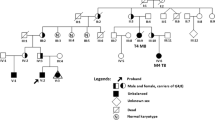Abstract
Five polymorphic index markers were analyzed by polymerase chain reaction (PCR) to ascertain the parental origin of the extra X chromosomes in seven polysomic cases (one 49,XXXXX, three 49,XXXXY, two 48,XXXY, and one 48, XXYY). All four X chromosomes in 49, X polysomies were maternal in origin and the extra X chromosomes in 48 X polysomies were paternal. In each case the multiple X chromosomes were contributed by a single parent. Taken together with previously reported cases, these data support a single mechanism of sequential nondisjunction during either maternal or paternal gametogenesis as the cause of higher order sex chromosome polysomy.
Similar content being viewed by others
References
Allen RC, Belmont JW (1992) Dinucleotide repeat polymorphism at the DXS178 locus. Hum Mol Genet 1:216
Allen RC, Belmont JW (1993) Trinucleotide repeat polymorphism at DXS101 locus. Hum Mol Genet 2:1508
Allen RC, Spriggs MK, Belmont JW (1993) Dinucleotide repeat in the CD40 ligand gene. Hum Mol Genet 2:828
David D, Márquez RA, Carreiro MH, Moreira I, Boavida MG (1992) Parental origin of extra chromosomes in persons with X chromosome tetrasomy. J Med Genet 29:59–596
Deng H-X, Abe K, Kondo I, Tsukahara M, Inagaki H, Hamada I (1991) Parental origin and mechanism of formation of polysomy X: an XXXXX case and four XXXXY cases determinated with RFLPs. Hum Genet 86:541–544
Greenstein RM, Harris DJ, Luzzatti L, Cann HW (1970) Cytogenetic analysis of a boy with the XXXY syndrome: origin of the X-chromosomes. Pediatrics 45:677–685
Grouchy J de, Turleau C (1984) Clinical atlas of human chromosomes. Wiley, New York
Hassold T, Pettay D, May K, Robinson A (1990) Analysis of non-disjunction in sex chromosome tetrasomy and pentasomy. Hum Genet 85:648–650
Huang THM, Greenberg F, Ledbetter DH (1991) Determination of the origin of nondisjunction in a 49,XXXXY male using hypervariable dinucleotide repeat sequences. Hum Genet 86:619–620
Kleczkowska A, Fryns JP, Van den Berghe H (1988) X-chromosome polysomy in the male: the Leuven experience 1966–1987. Hum Genet 80:16–22
Lorda-Sánchez I, Binkert F, Hinkel KG, Moser H, Rosenkranz W, Maechler M, Schinzel A (1992) Uniparental origin of sex chromosome polysomies. Hum Hered 42: 193–197
Maniatis T, Fritsch E, Sambrook J (1982) Molecular cloning: a laboratory manual. Cold Spring Harbor Laboratory, Cold Spring Harbor, NY
May KM, Jacobs PA, Lee M, Ratcliffe S, Robinson A, Nielsen J, Hassold TJ (1990) The parental origin of the extra X chromosome in 47,XXX females. Am J Hum Genet 46:754–761
Miller SA, Dykes DD, Polesky HF (1988) A simple salting out procedure for extracting DNA from human nucleated cells. Nucleic Acids Res 16:1215
Pfeiffer RA, Sanger R (1973) Origin of 48,XXXY: the evidence of the Xg blood groups. J Med Genet 10:142
Plaha DS, Duckett DP, Collacott RA, Young ID (1990) Origin of the X chromosomes in a patient with the 49,XXXXY syndrome. J Med Genet 27:203–204
Rinaldi A, Archidiacono N, Rocchi M, Filippi G (1979) Additional pedrigree supporting the frequent origin of XXYY from consecutive non-disjunction in paternal gametogenesis. J Med Genet 16:225–226
Sanger R, Tippett P, Gavin J (1971) Xg groups and sex abnormalities in people of northern European ancestry. J Med Genet 8: 417–426
Sherman SL, Takaesu N, Freeman SB Grantham M, Phillips C, Blackston RD, Jacobs PA, Cockwell AE, Freeman V, Uchida I, Mikkelsen M, Kurnit DM, Buraczynska M, Keats BJB, Hassold TJ (1991) Trisomy 21: association between reduced recombination and nondisjunction. Am J Hum Genet 49:608–620
Villamar M, Benitez J, Fernández E, Ayuso C, Ramos C (1989) Parental origin of chromosomal nondisjunction in a 49,XXXXY male using recombinant-DNA techniques. Clin Genet 36:152–155
Weber JL (1990) Informativeness of human (dC-dA)n.(dG-dT) polymorphisms. Genomics 7:524–530
Weber JL, May PE (1989) Abundant class of human DNA polymorphism which can be typed using the polymerase chain reaction. Am J Hum Genet 44:388–396
Author information
Authors and Affiliations
Rights and permissions
About this article
Cite this article
Leal, C.A., Belmont, J.W., Nachtman, R. et al. Parental origin of the extra chromosomes in polysomy X. Hum Genet 94, 423–426 (1994). https://doi.org/10.1007/BF00201605
Received:
Revised:
Issue Date:
DOI: https://doi.org/10.1007/BF00201605




